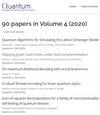Decoding quantum color codes with MaxSAT
IF 5.1
2区 物理与天体物理
Q1 PHYSICS, MULTIDISCIPLINARY
引用次数: 0
Abstract
In classical computing, error-correcting codes are well established and are ubiquitous both in theory and practical applications. For quantum computing, error-correction is essential as well, but harder to realize, coming along with substantial resource overheads and being concomitant with needs for substantial classical computing. Quantum error-correcting codes play a central role on the avenue towards fault-tolerant quantum computation beyond presumed near-term applications. Among those, color codes constitute a particularly important class of quantum codes that have gained interest in recent years due to favourable properties over other codes. As in classical computing, $decoding$ is the problem of inferring an operation to restore an uncorrupted state from a corrupted one and is central in the development of fault-tolerant quantum devices. In this work, we show how the decoding problem for color codes can be reduced to a slight variation of the well-known $\texttt{LightsOut}$ puzzle. We propose a novel decoder for quantum color codes using a formulation as a MaxSAT problem based on this analogy. Furthermore, we optimize the MaxSAT construction and show numerically that the decoding performance of the proposed decoder achieves state-of-the-art decoding performance on color codes. The implementation of the decoder as well as tools to automatically conduct numerical experiments are publicly available as part of the $\textit{Munich Quantum Toolkit}$ (MQT) on GitHub.用 MaxSAT 解码量子色码
在经典计算中,纠错码已经非常成熟,在理论和实际应用中无处不在。对于量子计算来说,纠错也是必不可少的,但却更难实现,因为纠错会带来巨大的资源开销,同时还需要大量的经典计算。量子纠错码在通往容错量子计算的道路上扮演着核心角色,超越了假定的近期应用。其中,颜色代码是一类特别重要的量子代码,由于其优于其他代码的特性,近年来备受关注。与经典计算一样,"解码 "也是推断操作以从损坏状态恢复未损坏状态的问题,是容错量子设备开发的核心。在这项工作中,我们展示了如何将彩色代码的解码问题简化为著名的$texttt{LightsOut}$谜题的细微变化。基于这种类比,我们提出了一种新型量子色码解码器,并将其表述为 MaxSAT 问题。此外,我们还对 MaxSAT 结构进行了优化,并用数值证明了所提解码器的解码性能达到了最先进的色码解码性能。作为 GitHub 上 $\textit{Munich Quantum Toolkit}$ (MQT) 的一部分,解码器的实现以及自动进行数值实验的工具都是公开的。
本文章由计算机程序翻译,如有差异,请以英文原文为准。
求助全文
约1分钟内获得全文
求助全文
来源期刊

Quantum
Physics and Astronomy-Physics and Astronomy (miscellaneous)
CiteScore
9.20
自引率
10.90%
发文量
241
审稿时长
16 weeks
期刊介绍:
Quantum is an open-access peer-reviewed journal for quantum science and related fields. Quantum is non-profit and community-run: an effort by researchers and for researchers to make science more open and publishing more transparent and efficient.
 求助内容:
求助内容: 应助结果提醒方式:
应助结果提醒方式:


